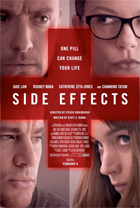Side Effects
|  Similar to Contagion (2011), the previous collaboration between writer Scott Z. Burns and director Steven Soderbergh, Side Effects is a slick, entertaining piece of Hollywood genre work that includes just enough twists and tweaks to make it stand out from the parade of similar thrillers, if just barely. Soderbergh’s chameleonic presence is certainly in evidence throughout the film (which he claims will be his swan song before entering permanent cinematic retirement at age 50), although one could easily imagine a slightly cheaper, less imaginative version with B-level actors unspooling on the Lifetime Movie Network. Similar to Contagion (2011), the previous collaboration between writer Scott Z. Burns and director Steven Soderbergh, Side Effects is a slick, entertaining piece of Hollywood genre work that includes just enough twists and tweaks to make it stand out from the parade of similar thrillers, if just barely. Soderbergh’s chameleonic presence is certainly in evidence throughout the film (which he claims will be his swan song before entering permanent cinematic retirement at age 50), although one could easily imagine a slightly cheaper, less imaginative version with B-level actors unspooling on the Lifetime Movie Network.The story takes place largely within the complex world of medical psychiatry and the pharmaceutical industry that regularly touts and pushes new drugs as the answer to all mental problems. Give that much of the film’s pleasure is the twisting and turning of the plot, which starts in one direction and proceeds steadily before taking a strong turn midway through, I will be very general in describing it. The film initially centers of Emily Taylor (Rooney Mara), a young woman whose husband, Martin (Channing Tatum), is about to be released from prison after doing a four-year stint for insider training. Emily has suffered from depression for years, and in a momentary lapse of reason does something that could have killed her, which lands her under the care of Dr. Jonathan Banks (Jude Law), an ambitious, overworked psychiatrist with a new wife (Vinessa Shaw), stepson, and chic Manhattan lifestyle to maintain. In an effort to help her, Dr. Banks collaborates with Dr. Victoria Siebert (Catherine Zeta-Jones), Emily’s previous psychiatrist in Greenwich, also his attention is somewhat diverted by his getting involving with a pharmaceutical company’s new trial for an anti-depressant. Dr. Banks is not a bad man or a bad doctor; rather, he’s just another cog in the medical-industrial machine, trained in the art of prescribing one pill after another until he achieves the desired effect. Given that Soderbergh opens the film with an ominous tracking shot through an apartment spattered with gore and bloody footprints before jumping back in time three months, we know that something bad is going to happen soon; thus, the only questions are when, what, and to whom? Once we see what happens in the apartment, the focus of the story shifts to Dr. Banks, who finds that his life—both professional and personal—starts to unravel because of his involvement in Emily’s case, and the film quickly morphs from a topical drama with satirical overtones aimed at Big Pharma to a classical Hollywood wronged man thriller, in which Dr. Banks must fight against what appears to be a conspiracy designed to destroy him. The pieces of the puzzle start falling into place as it turns into one of those righteous-angry Liam Neeson movies, albeit with Jude Law clearing his name using his wits and devious plans of his own, rather than with fists and guns. Soderbergh is no hack, even when he’s purposefully working in the most mainstream of genre material, and he gives Side Effects a slick look that never detracts from the issues at hand (he is frequently attracted to “topical” movies when plying his studio trade, whether it be illegal drugs in Traffic or corporate malfeasance in Erin Brockovich). Acting as his own cinematographer (as always), he favors intense shallow focus, a sickly color palette, and close-ups in confined spaces to create a sense of claustrophobia as the world tightens its grip, first around Emily and then around Dr. Banks. Burns’ screenplay is loose enough to allow the film to lean in various directions without committing for some time, but sharp enough to maintain focus once the real story begins to come together. Unfortunately, the film loses some verve because Soderbergh plays it all so straight, which dilutes some of the inherent perversity of the characters’ behavior, particularly Dr. Banks’ in the film’s final minutes. There is a long history of righteous law breaking in American cinema, and Soderbergh and Burns seem to buy into it fully without ironic comment. Soderbergh has always attracted great Hollywood talent to his films, and here he’s working with a number of familiar faces, including Law (who also appeared in Contagion), Zeta-Jones (who previously starred in Traffic and Ocean’s Twelve), and Tatum (who previously worked with him on Haywire and Magic Mike). The new face belongs to Rooney Mara, who played the title role in David Fincher’s The Girl With the Dragon Tattoo (2010) and here displays a lithe, winsome Audrey Hepburn/Mia Farrow vibe that makes you forget entirely about black eyeliner and facial piercings. In many ways, Mara’s character is the key to the movie’s effectiveness, and she plays the part well, allowing our alliances and sympathies to shift as needed. Granted, Side Effects is no masterpiece—especially its ending, which wraps things up way too neatly and too quickly, as if Soderbergh couldn’t wait to get to his retirement. But, it is an entertaining enough thriller that, while not stuffed with ideas, has more on its mind than simply plot mechanics, even if said mechanics are ultimately what we remember. Copyright ©2013 James Kendrick Thoughts? E-mail James Kendrick All images copyright © Open Road Films |
Overall Rating: 

 (3)
(3)


